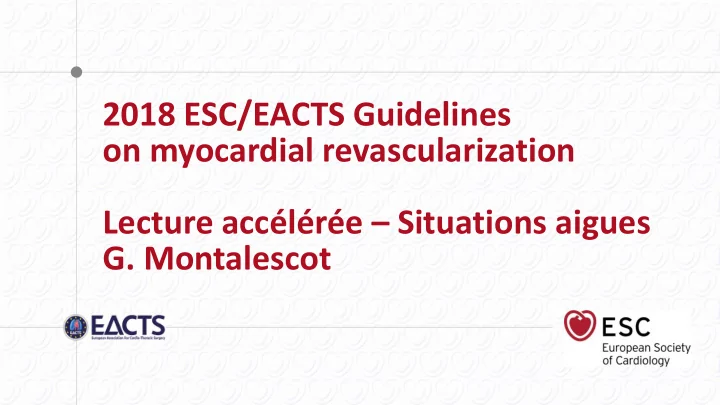

2018 ESC/EACTS Guidelines on myocardial revascularization Lecture accélérée – Situations aigues G. Montalescot
Selection of non-ST-elevation acute coronary syndrome treatment strategy and timing according to initial risk stratification Invasive evaluation in non-ST-elevation acute coronary syndromes Intermediate Risk Very High-Risk High-Risk • Haemodynamic instability or • Diabetes mellitus or renal • Established diagnosis of non- cardiogenic shock insufficiency ST-elevation myocardial • Recurrent/ongoing chest • LVEF <40% or congestive infarction based on cardiac pain refractory to medical txt troponins heart failure • Life-threatening arrhythmias • Early post-infarction • Dynamic ST-segment or T- or cardiac arrest angina or prior PCI/CABG • Mechanical complications of wave changes (symptomatic • GRACE risk sore >109 and or silent) MI • Acute heart failure <140 or recurrent • GRACE score >140 • Recurrent dynamic ST- symptoms/ischaemia on non-invasive testing segment or T-wave changes Immediate invasive (<2 hours) Early invasive (<24 hours) Invasive (<72 hours) IC IA IA 2 2018 ESC/EACTS Guidelines on myocardial revascularisation www.escardio.org/guidelines www.escardio.org/guidelines European Heart Journal (2018) 00, 1-96 - doi:10.1093/eurheartj/ehy394
Modes of patient’s medical contact, components of ischaemia time, and flowchart for reperfusion strategy selection Total ischaemic time Patient delay EMS delay System delay FMC: EMS <90’ <10 ‘ Primary PCI Reperfusion ≤120 min strategy (Wire crossing) STEMI ? Time diagnosis to PCI <10’ Fibrinolysis <10’ Reperfusion >120 min strategy (Lytic bolus) FMC: Non-PCI centre <10’ <60’ Primary PCI Reperfusion STEMI strategy (Wire crossing) FMC: PCI centre diagnosis Patient delay System delay Total ischaemic time 3 2018 ESC/EACTS Guidelines on myocardial revascularisation www.escardio.org/guidelines www.escardio.org/guidelines European Heart Journal (2018) 00, 1-96 - doi:10.1093/eurheartj/ehy394
Fibrinolysis PREVENTS shock better than primary PCI! Vanhaverbeke et al. Circulation 2018, in press
How can fibrinolysis beat primary PCI? 1/ for every 10-min treatment delay 3.3 additional deaths per 100 PCI- treated patients occur! ( Scholz KH, FITT-STEMI, EHJ 2018) 2/ Several trials have shown that urgent recanalization of the culprit vessel is the key to prevent shock after STEMI Randomize IWRS Sx onset start rt-PA 148 ( 108-204 ) 57 ( 7-88 ) 210 ( 166-270 ) 70 min difference Sx onset Randomize IWRS sheath insertion 155 ( 114-210 ) 110 ( 50-160 ) 280 ( 214-340 ) 2 Hours 3 Hours n=344 Jun PU et al. Early MYO trial. Circ 2017
Benefit of fibrinolysis increases: In early presenters, when myocardium to salvage is larger With pre-hospital administration , when time-to-treatment is shortened more In young patients , when safety is preserved When global pharmacoinvasive approach is applied When secondary access to cath is available
Primary percutaneous coronary intervention for myocardial reperfusion in ST-elevation myocardial infarction: indications and logistics Recommendations Class Level Indication A primary PCI strategy is recommended over fibrinolysis within the I A indicated time frames. In patients with time from symptom onset >12 h, a primary PCI strategy is indicated in the presence of ongoing symptoms or signs suggestive of I C ischaemia, haemodynamic instability, or life-threatening arrhythmias. ? A routine primary PCI strategy should be considered in patients presenting IIa B late (12-48 h) after symptom onset. 7 2018 ESC/EACTS Guidelines on myocardial revascularisation www.escardio.org/guidelines www.escardio.org/guidelines European Heart Journal (2018) 00, 1-96 - doi:10.1093/eurheartj/ehy394
Primary percutaneous coronary intervention for myocardial reperfusion in ST-elevation myocardial infarction: procedural aspects (strategy and technique) Recommendations Class Level Strategy Routine revascularization of non-IRA lesions should be considered IIa A in patients with multivessel disease before hospital discharge. CABG should be considered in patients with ongoing ischaemia and ? large areas of jeopardized myocardium if PCI of the IRA cannot be IIa C performed. In cardiogenic shock, routine revascularization of non-IRA lesions is 8 2018 ESC/EACTS Guidelines on myocardial revascularisation www.escardio.org/guidelines www.escardio.org/guidelines European Heart Journal (2018) 00, 1-96 - doi:10.1093/eurheartj/ehy394
Algorithm for the management of Ventilatory support patients with cardiogenic complications shock 9 2018 ESC/EACTS Guidelines on myocardial revascularisation www.escardio.org/guidelines www.escardio.org/guidelines European Heart Journal (2018) 00, 1-96 - doi:10.1093/eurheartj/ehy394
Management of patients with cardiogenic shock Recommendations Class Level Emergency coronary angiography is indicated in patients with I B acute heart failure or cardiogenic shock complicating ACS. Emergency PCI of the culprit lesion is indicated for patients with cardiogenic shock due to STEMI or NSTE-ACS, independent of time I B delay of symptom onset, if coronary anatomy is amenable to PCI. ? Emergency CABG is recommended for patients with cardiogenic I B shock if the coronary anatomy is not amenable to PCI. In cases of haemodynamic instability, emergency surgical or ? catheter-based repair of mechanical complications of ACS is I C indicated, as decided by the Heart Team. 10 2018 ESC/EACTS Guidelines on myocardial revascularisation www.escardio.org/guidelines www.escardio.org/guidelines European Heart Journal (2018) 00, 1-96 - doi:10.1093/eurheartj/ehy394
The treatment of Shock Mechanical complications Arrythmias Treat complications Hypovolemia Tamponade LVAD IABP RV infarction Large anterior MI Prior low EF (prior MI) Culprit vessel revasc Multivessel revasc Elderly/frailty
In selected patients with ACS and cardiogenic shock, short-term mechanical circulatory support may be ? considered, depending on patient age, comorbidities, IIb C neurological function, and the prospects for long-term survival and predicted quality of life. Routine use of IABPs in patients with cardiogenic III B shock due to ACS is not recommended. Assessment of ECMO in acute myocardial infarction with Non- reversible Cardiogenic shock to Halt Organ failure and Reduce mortality To determine if early VA-ECMO combined with IABP support and in conjunction with optimal medical treatment would improve 30-day outcome of patients with acute myocardial infarction complicated by cardiogenic shock as compared with optimal medical treatment alone The ECMO device will be the CardioHelp (MAQUET, GETINGE, Orléans, France) using the veno-arterial setting and percutaneous femoro-femoral cannulation
Recommend
More recommend